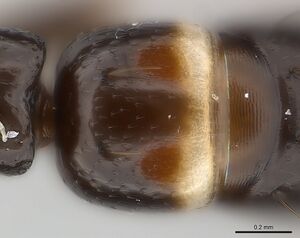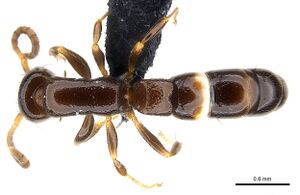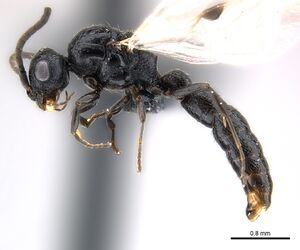Tanipone zona
| Tanipone zona | |
|---|---|

| |
| Scientific classification | |
| Kingdom: | Animalia |
| Phylum: | Arthropoda |
| Class: | Insecta |
| Order: | Hymenoptera |
| Family: | Formicidae |
| Subfamily: | Dorylinae |
| Genus: | Tanipone |
| Species: | V. zona |
| Binomial name | |
| Tanipone zona Bolton & Fisher, 2012 | |
Primarily terrestrial, material of zona has mostly been captured as ground foragers, under stones, in leaf litter samples, in rotten tree stumps and logs, and in pitfall traps. It has also been recovered from low vegetation, but much more rarely. Primarily found in tropical dry forest, spiny forest, or Uapaca woodland, but it has also been discovered in gallery forest, littoral rainforest and mangroves.
Identification
A member of the maculata species group. Very closely related to Tanipone maculata, but in the latter the tergite of AIII has a pair of pale spots that are separated by a median longitudinal dark strip, rather than the continuous transverse pale band of approximately uniform width that is characteristic of zona. In addition, the setae are usually slightly more numerous in maculata. (Bolton and Fisher 2012)
Keys including this Species
Distribution
Latitudinal Distribution Pattern
Latitudinal Range: -24.1° to -24.1°.
| North Temperate |
North Subtropical |
Tropical | South Subtropical |
South Temperate |
- Source: AntMaps
Distribution based on Regional Taxon Lists
Malagasy Region: Madagascar (type locality).
Distribution based on AntMaps
Distribution based on AntWeb specimens
Check data from AntWeb
Countries Occupied
| Number of countries occupied by this species based on AntWiki Regional Taxon Lists. In general, fewer countries occupied indicates a narrower range, while more countries indicates a more widespread species. |

|
Estimated Abundance
| Relative abundance based on number of AntMaps records per species (this species within the purple bar). Fewer records (to the left) indicates a less abundant/encountered species while more records (to the right) indicates more abundant/encountered species. |

|
Biology
Castes
Images from AntWeb

| |
| Worker. Specimen code casent0001187. Photographer Erin Prado, uploaded by California Academy of Sciences. | Owned by CAS, San Francisco, CA, USA. |
 
| |
| Specimen code casent0010023. . | |
Worker
Images from AntWeb
    
| |
| Holotype of Tanipone zona. Worker. Specimen code casent0020383. Photographer Shannon Hartman, uploaded by California Academy of Sciences. | Owned by CAS, San Francisco, CA, USA. |
    
| |
| Worker. Specimen code casent0491199. Photographer April Nobile, uploaded by California Academy of Sciences. | Owned by CAS, San Francisco, CA, USA. |
    
| |
| Worker. Specimen code casent0137652. Photographer Erin Prado, uploaded by California Academy of Sciences. | Owned by CAS, San Francisco, CA, USA. |
   
| |
| Worker. Specimen code casent0020379. Photographer Erin Prado, uploaded by California Academy of Sciences. | Owned by CAS, San Francisco, CA, USA. |
Male
Images from AntWeb
      
| |
| Male (alate). Specimen code casent0168822. Photographer Erin Prado, uploaded by California Academy of Sciences. | Owned by CAS, San Francisco, CA, USA. |
Nomenclature
The following information is derived from Barry Bolton's Online Catalogue of the Ants of the World.
- zona. Tanipone zona Bolton & Fisher, 2012: 98, figs. 84, 85, 113-115 (w.m.) MADAGASCAR.
- Type-material: holotype worker, 7 paratype worker.
- Type-locality: holotype Madagascar: Prov. Toliara, P.N. Tsimanampetsotsa, 6.7 km. 130° SE Efoetse, 24°06’S, 43°46’E, 18-22.iii.2002, BLF6169(50), CASENT0020383, sifted litter, spiny forest/thicket (B.L. Fisher); paratypes with same data but coded BLF6160(10) CASENT0020374, BLF6160(29) CASENT0020377, BLF6160(31) CASENT0020378, BLF6160(33) CASENT0020379, BLF6160(37) CASENT0020380, BLF6160(46) CASENT0020382, BLF6160(LO) CASENT0020384.
- Type-depository: CASC.
- Distribution: Madagascar.
Unless otherwise noted the text for the remainder of this section is reported from the publication that includes the original description.
Description
Worker
holotype in parentheses). HL 0.68–0.81 (0.76), HW 0.53–0.63 (0.60), SL 0.30–0.40 (0.34), EL 0.23–0.29 (0.28), PW 0.39–0.50 (0.46), AIIW 0.36–0.47 (0.44), AIIL 0.36–0.44 (0.44), AIIIW 0.46–0.59 (0.55), AIIIL 0.36–0.50 (0.44), WL 0.80–1.04 (1.00), MFL 0.46–0.58 (0.54), CI 73–79 (79), SI 55–63 (57), EL/HW 0.44–0.48 (0.47), AIIW/AIIL 0.96–1.12 (1.00), AIIIW/AIIIL 1.16–1.30 (1.25) (12 measured).
Cephalic pilosity and structure of AIII glandular patches as described in definition of maculata group, above. With head in full-face view the side in front of the eye without a laterally projecting seta behind the level of the posterior clypeal margin. Posterior margin of head with 2 setae. Dorsum of pronotum with a single pair of setae, at the humeri; mesonotum and propodeum usually without setae but very rarely the mesonotum with a single short pair present. Mesofemur and metafemur in dorsal view without projecting setae on the anterior or posterior surfaces. Ventral surfaces of mesofemur and metafemur usually without projecting setae, but very rarely a short seta present just distal of the trochanter. Dorsal surface of AII (petiole) with an anterior pair of setae; usually without setae posteriorly but in one specimen a short pair present on the posterior margin. Tergite of AIII with two setae anteriorly, each of which is situated well in front of the anterior margin of the glandular patch. Tergite of AIV with 2–4 setae anteriorly; in general segments AIII and AIV without setae posteriorly, but extremely rarely a short pair present at the posterior margin of one or both sclerites. Sternites of AIII and AIV with setae present. Cephalic dorsum with scattered small punctures, their diameters obviously less than the distances between them. Spaces between punctures smooth or with vestigial ground sculpture, except behind antennal fossae, where weak ground sculpture is usually visible. Katepisternum mostly to entirely smooth. Dorsum of mesosoma with scattered small punctures, as on the head their diameters are obviously less than the distances between them. AII (petiole) in dorsal view appears slightly broader than long; in profile its tergite appears longer than high. Tergite of AIII, between the glandular patches smooth, with minute punctures and sometimes traces of vestigial superficial sculpture. The pale band at the apex of AIII tergite is always very obvious and is of approximately equal width across the sclerite; never interrupted by a longitudinal dark median strip. Tergite of AIV sparsely punctate, often with spaces between punctures smooth, but sometimes with feeble ground sculpture. Full adult colour dark brown to blackish brown (except for the distinct pale band on AIII).
Type Material
Holotype worker, Madagascar: Prov. Toliara, P.N. Tsimanampetsotsa, 6.7 km 130° SE Efoetse, 24°06’S, 43°46’E, 18-22.iii.2002, BLF6169(50), CASENT0020383, sifted litter, spiny forest/thicket (B.L. Fisher) (California Academy of Sciences). Paratypes. 7 workers with same data as holotype but coded 6160(10), CASENT0020374; 6160(29), CASENT0020377; 6160(31), CASENT0020378; 6160(33), CASENT0020379; 6160(37), CASENT0020380; 6160(46), CASENT0020382 (specimen fragmented); 6160(L0), CASENT0020384 (CASC).
References
- Bolton, B. & Fisher, B.L. 2012. Taxonomy of the cerapachyine ant genera Simopone Forel, Vicinopone gen. n. and Tanipone gen. n. (Hymenoptera: Formicidae). Zootaxa 3283, 1–101 (doi:10.11646/zootaxa.3283.1.1).
- Borowiec, M.L. 2019. Convergent evolution of the army ant syndrome and congruence in big-data phylogenetics. Systematic Biology 68, 642–656 (doi:10.1093/sysbio/syy088).
References based on Global Ant Biodiversity Informatics
- Blaimer B. B., S. G. Brady, T. R. Schultz, and B. L. Fisher. 2015. Fucntional and phylogenetic approaches reveal the evolution of diversity in a hyper diverse biota. Ecography 38: 001-012.
- Bolton B., and B. L. Fisher. 2012. Taxonomy of the cerapachyine ant genera Simopone Forel, Vicinopone gen. n. and Tanipone gen. n. (Hymenoptera: Formicidae). Zootaxa 3283: 1-101.
- Borowiec M. L. 2016. Generic revision of the ant subfamily Dorylinae (Hymenoptera, Formicidae). ZooKeys 608: 1–280.

